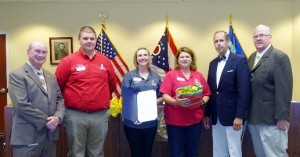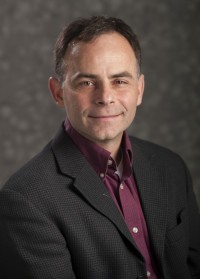Boasting beautiful beaches for sunbathing and swimming, healthy populations of walleye and perch for sport fishing, and plenty of open water for boating, Lake Erie brings both economic gain to coastal communities and enjoyment to recreation seekers. But, despite all of the fun being had in the sun, did you know that coastal storms that blow across the Lake before touching land on Ohio’s north coast bring their fair share of problems, too?
 Coastal storms and resulting flood events have historically been the most destructive natural hazards in northern Ohio. In fact, Ohio’s Hazards Mitigation Plan names flooding and coastal flooding as the top two most important hazards impacting the entire state. In Cuyahoga County alone, storms and heavy rains are responsible for over $650 million in damages since 1950. Making matters worse, the impacts of coastal storms are not limited to just flooding. Other hazards caused by storms can include erosion of river banks and coastline, damage to transportation routes and public utilities, combined sewer overflows, dangerous currents in the Lake, and runoff that can contribute to the formation of harmful algal blooms.
Coastal storms and resulting flood events have historically been the most destructive natural hazards in northern Ohio. In fact, Ohio’s Hazards Mitigation Plan names flooding and coastal flooding as the top two most important hazards impacting the entire state. In Cuyahoga County alone, storms and heavy rains are responsible for over $650 million in damages since 1950. Making matters worse, the impacts of coastal storms are not limited to just flooding. Other hazards caused by storms can include erosion of river banks and coastline, damage to transportation routes and public utilities, combined sewer overflows, dangerous currents in the Lake, and runoff that can contribute to the formation of harmful algal blooms.
To prepare for coastal storms, it is important to understand who is most vulnerable. That is, who has the greatest potential for loss of property, infrastructure, or even human life. Some of the factors that influence a person or community’s potential for loss from natural hazards like coastal storms include: frailty and physical limitations; lack of access to resources (information, knowledge, technology); limited political power and representation; eroded social networks and connections; dilapidated building stock; and poorly maintained infrastructure (Cutter et al., 2003).
Identifying populations that are most vulnerable can help local decision makers create plans for building resilience to storm hazards. More importantly, valuable resources for hazards mitigation can be targeted at the populations that are the most in need.
This has become a priority in the Great Lakes region in recent years with the support of the National Oceanic and Atmospheric Administration (NOAA) Coastal Storms Program (CSP). The CSP seeks to make communities safer by reducing the loss of life and negative impacts of coastal storms via collaboration with academic institutions like The Ohio State University, government agencies, and even nongovernmental organizations to address regional priorities.
Another source of support for coastal storms research and outreach comes from the NOAA Office for Coastal Management. Specifically, their Digital Coast website provides users data, tools, and training needed to increase resiliency to severe storms and other issues facing coastal communities.
If you are interested in knowing more about how to make our north coast safer and more ecologically and economically sustainable for local populations and tourists alike, check out these additional efforts to better understand and prepare for coastal storms in the Great Lakes.
Scott Hardy is an Extension Educator with the Ohio Sea Grant College Program.
Cutter, S., Boruff, B., and Shirley, W. 2003. “Social Vulnerability to Environmental Hazards.” Social Science Quarterly: 84 (2) 242-261.
Cuyahoga County Office of Emergency Management. 2011. “Countywide All Natural Hazards Mitigation Plan.” Web reference accessed 8.16.2016. < ja.cuyahogacounty.us>
Ohio Department of Public Safety. 2011. “State of Ohio Hazard Mitigation Plan.” Web reference accessed 7.25.2016. <ema.ohio.gov/Mitigation_OhioPlan.aspx>.

 dership development program has enabled participants to come together to collaborative in addressing a significant community challenge.
dership development program has enabled participants to come together to collaborative in addressing a significant community challenge. After a very engaging and successful Ohio Local Foods week in August, there was a variety of interest expressed in pursuing a center for small business owners to collaborate within Clermont County. As envisioned, this center would incorporate an incubator kitchen for cottage foods producers and other locally sourced value-added products to supply a wide variety of market sectors within the agriculture industry of Clermont County. A preliminary working group has been established to facilitate the process. Over the coming weeks the group will research facilities and design after which a larger group of producers and supporters will be convened to expand upon the foundation work and decide on the next steps in this venture.
After a very engaging and successful Ohio Local Foods week in August, there was a variety of interest expressed in pursuing a center for small business owners to collaborate within Clermont County. As envisioned, this center would incorporate an incubator kitchen for cottage foods producers and other locally sourced value-added products to supply a wide variety of market sectors within the agriculture industry of Clermont County. A preliminary working group has been established to facilitate the process. Over the coming weeks the group will research facilities and design after which a larger group of producers and supporters will be convened to expand upon the foundation work and decide on the next steps in this venture. Leadership! It is a basic fundamental need for any organization to perform as a well-balanced machine. We have learned from an earlier developed plan of work that addressing the needs of county elected officials is a necessity. Many of the public officials I met with during the first few months in my position confirmed this need. They have asked for education in leadership development, conducting effective meetings, communicating more effectively, and other key areas. Based upon these conversations, the
Leadership! It is a basic fundamental need for any organization to perform as a well-balanced machine. We have learned from an earlier developed plan of work that addressing the needs of county elected officials is a necessity. Many of the public officials I met with during the first few months in my position confirmed this need. They have asked for education in leadership development, conducting effective meetings, communicating more effectively, and other key areas. Based upon these conversations, the  Through early discussions with townships and villages, many officials and community members have expressed an interest in strategic planning and goal setting for their communities. This has added to the growing excitement of expansion and redevelopment of infrastructure throughout Clermont County, and community-based projects of this nature are currently being planned.
Through early discussions with townships and villages, many officials and community members have expressed an interest in strategic planning and goal setting for their communities. This has added to the growing excitement of expansion and redevelopment of infrastructure throughout Clermont County, and community-based projects of this nature are currently being planned. Next, an announcement was made last week regarding a new BRE-customized mobile application that is now ready for commercial release. The mobile application is a highly anticipated outcome of a North Central Regional Center for Rural Development (NCRCRD) multi-state collaborative grant project to elevate and expand the BRE program in the region and throughout the U.S. The team of Ohio, Indiana and Iowa researchers identified the application as a way to revolutionize how data is collected for BRE tracking and reporting. A demonstration and presentation of the mobile application will take place at the International Economic Development Council (IEDC) annual conference September 25 in Cleveland (see program description and speakers below).
Next, an announcement was made last week regarding a new BRE-customized mobile application that is now ready for commercial release. The mobile application is a highly anticipated outcome of a North Central Regional Center for Rural Development (NCRCRD) multi-state collaborative grant project to elevate and expand the BRE program in the region and throughout the U.S. The team of Ohio, Indiana and Iowa researchers identified the application as a way to revolutionize how data is collected for BRE tracking and reporting. A demonstration and presentation of the mobile application will take place at the International Economic Development Council (IEDC) annual conference September 25 in Cleveland (see program description and speakers below). Coastal storms and resulting flood events have historically been the most destructive natural hazards in northern Ohio. In fact, Ohio’s Hazards Mitigation Plan names flooding and coastal flooding as the top two most important hazards impacting the entire state. In Cuyahoga County alone, storms and heavy rains are responsible for over $650 million in damages since 1950. Making matters worse, the impacts of coastal storms are not limited to just flooding. Other hazards caused by storms can include erosion of river banks and coastline, damage to transportation routes and public utilities, combined sewer overflows, dangerous currents in the Lake, and runoff that can contribute to the formation of harmful algal blooms.
Coastal storms and resulting flood events have historically been the most destructive natural hazards in northern Ohio. In fact, Ohio’s Hazards Mitigation Plan names flooding and coastal flooding as the top two most important hazards impacting the entire state. In Cuyahoga County alone, storms and heavy rains are responsible for over $650 million in damages since 1950. Making matters worse, the impacts of coastal storms are not limited to just flooding. Other hazards caused by storms can include erosion of river banks and coastline, damage to transportation routes and public utilities, combined sewer overflows, dangerous currents in the Lake, and runoff that can contribute to the formation of harmful algal blooms.